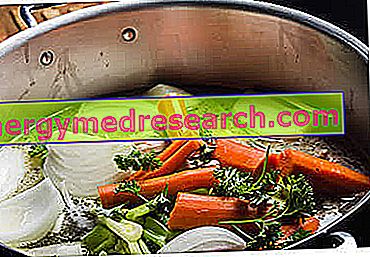What is Vegetable Broth?
Vegetable broth is a kitchen base widely used for cooking and serving various types of recipes.
In broth we cook and serve many first courses ( pasta or rice in broth, tortellini, canederli, passatelli, shredded eggs etc.); moreover, the broth is used to lengthen the cooking liquids of the roast in the oven, of the stews in fricassee or casserole etc.

Vegetable broth is a liquid / transparent drink / food with an intense amber or light yellow color (tending to greenish or red, depending on the ingredients), with a delicate aroma of boiled vegetables and an equally light taste.
The vegetable broth does not contain large amounts of nutrients, which mostly involve the saline fraction (especially sodium and potassium ) and some natural dyes (eg carotenoids ); depending on the vegetables used in the formula, even a few simple carbohydrates ( fructose ) or complex seeds ( malt-dextrin ) can be dissolved in water.
If commercial (in nut, powder or granular, in bricks, in thickened single portions, etc.), vegetable broth may show more or less high levels of food additives (eg sodium glutamate ).
The "homemade" vegetable broth is produced only with vegetables and water.
Home Made Vegetable Broth
The homemade vegetable broth is certainly not one of the most complex recipes. It is necessary to keep in mind only a few tricks and "don't be in a hurry" during the preparation. To be honest, compared to meat or fish, the preparation of vegetable broth takes much longer; this is due to the fact that the vegetable tissues are much more sensitive to heat treatment than the muscular, connective and bony ones of animals.
In addition to water, the basic ingredients of vegetable broth are only three: celery, carrot and onion, in the proportion 2: 2: 1. Many others also use zucchini, tomatoes and potatoes, as well as various aromatic herbs and spices among which are mainly: fresh parsley, fresh bay leaves, garlic and peppercorns. If the vegetable broth is intended to serve as a cooking liquid, it should be slightly salted; on the contrary, if it is simply a base for hydration, it is advisable to leave it completely tasteless.
The procedure is rather trivial; we specify immediately that, being a broth, the vegetables must be cut into pieces and cooked in "cold water". This "pun" simply indicates that, at the time of the vegetable dip, the temperature of the liquid should be "environment". By cooking in cold water, a greater perfusion of the nutrients in the broth is obtained, ie the edible portion of the recipe itself; on the contrary, to cook the "boiled or boiled vegetables" the opposite principle should be respected, that is to plunge them whole in "hot water" (at maximum boiling, to limit the dispersion of the aforementioned molecules).
NB . In the "whitening" or "bleaching", the temperature of the water is the same as that of boiled or boiled vegetables, with the difference that the ingredients are already cut into their final form and undergo the action of heat for a very short time.
Vegetable Broth - All the Tricks to Prepare It
X Problems with video playback? Reload from YouTube Go to Video Page Go to Video Recipes Section Watch the video on youtubeIngredients processing
Vegetable broth vegetables must be processed differently from one another. They must all be washed, cleaned and cut; the smaller the pieces, the shorter the cooking time and the greater the cloudiness. On the other hand, the ingredients require a fairly specific cleansing:
- Celery: the green one is better; it is necessary that it is deprived of the leaves (slightly bitter) and of the extremity on which the roots begin.
- Carrots: they must be peeled (the external portion is slightly bitter) and deprived of the extremity on which the tuft begins.
- Onion: better white or yellow; it must be peeled and the two ends removed.
NB . Some use to burn pieces of onion in a pan and add them to the broth to give it a pleasant amber hue; this is NOT to be considered a healthy practice, due to the production of various toxic molecules in the Maillard reaction.
- Courgettes: they are deprived of the two ends.
- Tomatoes: generally the copper variety is used but the San Marzano are also fine; some peel them and leave them whole. You can also leave it with the peel and cut into 4 wedges, since this separates automatically during cooking.
- Potatoes: any size; they must be peeled and peeled in order to eliminate any trace of buds (these parts contain traces of solanine, a harmful molecule).
- Parsley: unlike celery, only the leaves are used. Better to add it at the end of cooking, with the heat off.
- Laurel: large leaves are preferred. Some suggest using several in a few liters of water. For my part, I suggest using only one and cutting it into three parts. Better to add them at the end of cooking, with the heat off.
- Garlic: some suggest to combine it with the other ingredients and leave it "poached" (with the peel); personally, I prefer to add it cut in half, without peel, and at the end of cooking with the fire off.
- Pepper in grains: using the black one, it can be added slightly crushed, at the end of cooking and with the fire off; preferring the green pepper, I suggest to crush it with a pestle and to combine it with the vegetables at the beginning of the preparation.
The ingredients to be added at the end of cooking, with the fire off, should be left in the pot about 15-30 '; in this way they have time to transfer their characteristics to the broth and allow the suspension of the liquid to be decanted.
The procedure for the preparation of the vegetable broth could therefore be summarized as follows:
- wash and clean the vegetables (even those to be added at the end);
- fill a saucepan or a pot with water for 3/4;
- throw the ingredients;
- cover with a lid and put on the flame at minimum flame;
- allow to simmer (DO NOT boil) about 60 ';
- pull down from the heat, add the last ingredients and leave to rest 15-30 ';
- strain and adjust salt if necessary.
Commercial Vegetable Broth
The commercial vegetable broth (as well as that of meat and fish) is distributed under various formats, including: stock cube, powdered or granular broth, gelled broth / thickened portion, liquid broth in bricks etc.
The commercial vegetable broth is considered a product of poor quality, due to the massive presence of sodium glutamate (additive flavor enhancer) or of ingredients that contain it (a method that allowed consumers to be deceived by inserting the words: “without glutamate of added sodium "). The other ingredients of the commercial vegetable broth are: vegetables, extracts, seasoning fats, flavorings and other additives such as preservatives.
Being an additive, sodium glutamate is rather feared by most users; in reality, it is the sodium salt of an amino acid (normal constituent of proteins) called glutamic acid . Obviously, its massive presence contributes to dramatically increase the share of sodium food, an unwanted nutritional aspect especially for those suffering from primary arterial hypertension and discomfort of gastric mucosa.
By itself, sodium glutamate is not a particularly harmful element, although for a long period of time it has been considered responsible for the onset of some undesirable symptoms enclosed under the heading "Chinese restaurant syndrome" (more likely referred to reactions histamine or allergic to peanuts, shellfish etc).
It is however possible to produce the vegetable broth at home and keep it; some systems are: under glass in liquid and sterilized form, liquid frozen in bags, frozen single-portion liquid in cubes, in the form of a nut, in sterilized cream under glass, etc.
For more information, see Alice's recipe: Vegetable Nut Preparation in Cream.



